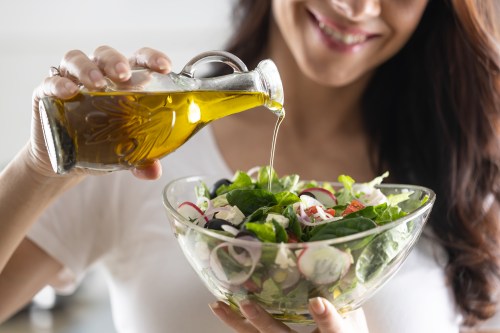Our editors independently select these products. Making a purchase through our links may earn Well+Good a commission
Whether it’s pollo guisado (stewed chicken), arroz con gandules (rice with pigeon peas), or ropa vieja (braised beef), you can name pretty much any classic Latin American dish and chances are high that the recipe calls for sofrito—a flavor base that involves cooking onions, garlic, tomatoes, and peppers in olive oil, along with a medley of spices. Used copiously in the Caribbean and many other parts of Latin America, sofrito is the foundation of the region’s flavorful, aromatic cuisine.
“It’s the one technique that really identifies the cooking of Latin America,” says Cuban-born food historian, chef, and restaurateur Maricel Presilla, author of the James Beard Award-winning cookbook Gran Cocina Latina.
Sofrito isn’t just loaded with flavor; with the right components, it can also be good for you. The ingredients in a typical sofrito—again, primarily tomatoes, olive oil, onion, and garlic—contain polyphenols and carotenoids, bioactive compounds that may offer protection against heart disease and some cancers, respectively. Researchers at the University of Barcelona found that cooking the ingredients together in a sofrito increases the levels of those bioactive compounds.
“Some of those nutrients are more easily absorbed when they are cooked than when they are fresh,” says Denver-based dietician Malena Perdomo, who hails from Panama. In other words? The ingredients are good for the heart on their own, but cooked into sofrito makes them even better.
While sofrito can be made with any kind of fat, the key to a healthy sofrito is olive oil, preferably the extra virgin variety.
“Over 75 percent of olive oil is monounsaturated fat,” Perdomo says. “When you are using olive oil instead of saturated fat, it’s good for the heart.”
Varieties of sofrito
Sofrito, Presilla explains, originated in medieval Spain. Colonizers introduced the technique in the Americas, where the recipe has been adapted a number of ways, based in part on the ingredients that are available in a particular region. As a result, while the main components are usually similar, there’s no single, standard recipe for sofrito.
A typical Puerto Rican sofrito, for instance, is heavy on culantro, an herb also known locally as recao. In Puerto Rico, sofrito is therefore also called recaito, and is, in the words of Puerto Rican-born food writer Von Diaz, “inextricable from the cuisine.”
“Oftentimes what folks might describe as a Puerto Rican flavor profile comes from the process of using sofrito,” says Diaz, who is the author of Coconuts & Collards: Recipes and Stories from Puerto Rico to the Deep South.
While sofrito is often associated with the Caribbean—it is prominent in Cuban and Dominican cuisines as well—the technique is used in many parts of Latin America, albeit sometimes under a different term. In Ecuador, for instance, it is called refrito. In Peru it goes by aderezo.
The technique is used in many parts of Latin America, albeit sometimes under a different term. In Ecuador, for instance, it is called refrito. In Peru it goes by aderezo.
Cooking with sofrito
Made with ingredients that are widely available, sofrito is a simple—and vegan—way to add a burst of Latin flavor to homemade meals, particularly stews, soups, and bean dishes. And it’s easy to customize based on your taste or what’s in your pantry. Perdomo, for example, likes to toss carrots into her sofrito, and she’s not against using tomato sauce in lieu of fresh tomatoes. When she can’t find culantro, Diaz reaches for a combination of parsley and cilantro.
Whichever version of sofrito you go with, Perdomo emphasizes the importance of cooking the vegetables slowly over until they soften, in order to extract the most flavor.
“Sofrito is not just sautéing or frying the vegetables in olive oil,” she says. “It’s slow cooking those vegetables until they soften. That’s when you start adding salt and dry herbs.”
Sofrito is so potent that for most dishes you only need a few tablespoons.
“It can do so much in small amounts and can turn something that is otherwise basic or bland into something that’s truly remarkable,” says Diaz. To save time, Diaz likes to make her sofrito in batches and freeze it in small portions.
“You can pull it out of the freezer and put it right in the pan,” she says. “You don’t even have to defrost it. It works beautifully.”
Easy Homemade Sofrito (from my own recipe)
Ingredients
1 large bell pepper, cored and seeded
2 Spanish onions
3 large garlic cloves, peeled
3 plum tomatoes, diced
½ cup extra virgin olive oil
1 tsp dry oregano
¼ tsp ground cumin
1 bay leaf
Salt and pepper to taste
- 1.Chop the vegetables into small pieces, either by hand or in a food processor.
- 2.Heat the olive oil in a saucepan over medium heat.
- 3.Add onions and garlic to the hot oil. Cook until the onions are translucent.
- 4.Add pepper and stir until tender.
- 5.Add the spices and the bay leaf. Continue to simmer until all the flavors are combined.
- 6.Remove the bay leaf. Use right away or refrigerate in an air-tight container for up to two weeks.
Oh hi! You look like someone who loves free workouts, discounts for cult-fave wellness brands, and exclusive Well+Good content. Sign up for Well+, our online community of wellness insiders, and unlock your rewards instantly.
Sign Up for Our Daily Newsletter
Get all the latest in wellness, trends, food, fitness, beauty, and more delivered right to your inbox.
Got it, you've been added to our email list.











